|
|
|
Sort Order |
|
|
|
Items / Page
|
|
|
|
|
|
|
| Srl | Item |
| 1 |
ID:
149196
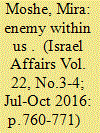

|
|
|
|
|
| Summary/Abstract |
Voting behaviour is often constructed by candidates’ ability to manipulate and set in motion voters’ social ‘nervous system’ by means of juxtaposing two social groups – ‘ours’ and ‘theirs’ – against one another. In the Israeli political arena, this means a sociopolitical ‘zero sum’ game between the right wing and the left wing. The present article seeks to decode the characteristics of right-wing vs. left-wing cognitive metaphors activated in the 2015 Israeli elections. Findings indicate that both sides sought to activate cultural schemes based on a sense of local belonging and social identity, with the emotional discourse focused on identifying and excluding internal enemies (i.e. those who are not ‘us’ or belong to ‘our group’).
|
|
|
|
|
|
|
|
|
|
|
|
|
|
|
|
| 2 |
ID:
153616
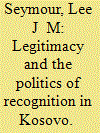

|
|
|
|
|
| Summary/Abstract |
How do contemporary secessionist movements gain international recognition of their claims to self-determination? I argue that international recognition is forthcoming when a sufficient number of states believe a claim to self-determination ought to be accepted. That is, states recognize claims to self-determination when they perceive them to be legitimate. To convince outsiders of the legitimacy of their claims, separatist movements invoke resonant norms and symbols in a moral economy that structures decision-making. I contrast this argument with prevailing explanations of recognition dynamics. To illustrate the argument, I examine the diplomacy surrounding Kosovo’s independence bid and unilateral secession.
|
|
|
|
|
|
|
|
|
|
|
|
|
|
|
|
| 3 |
ID:
100681
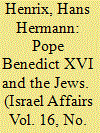

|
|
|
|
|
| Publication |
2010.
|
| Summary/Abstract |
The article deals with the question of whether the view that Benedict's relationship with the Jews needs to be regarded with suspicion is justified. Ratzinger's respective theology is scrutinized. Special attention is given to the contested Good Friday prayer for Jews as well as to the attempt at re-integrating the priests of the Pius X priest community. It cannot be denied that there is suspicion and ambiguity. In Benedict's view the fact that Israel is the foundation of Christian faith has been overshadowed. This firm belief has been expressed in Benedict's book on Jesus of Nazareth, during his visit to Israel in May 2009, and also during his address to the Jewish community in Rome in January 2010. The latter event is of particular importance. Benedict's address of 17 January 2010 can be seen as a central hermeneutical point of reference to understand Benedict's relationship with Judaism and the Jews. It is in the light of this point of reference that moments of suspicion can be counteracted. This does not mean, however, that Catholic-Jewish relations have been without irritations and tensions. But there is space for a constructive way of dealing with these frictions.
|
|
|
|
|
|
|
|
|
|
|
|
|
|
|
|
| 4 |
ID:
105905
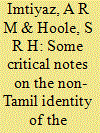

|
|
|
|
|
| Publication |
2011.
|
| Summary/Abstract |
The ethnic civil war between the Tamil and Sinhalese communities that ravaged Sri Lanka in the late twentieth and early twenty-first centuries and which ended in May 2009 has attracted great interest from scholars of ethnic identity. Both the Tamil and Sinhalese ethnic groups employ language-Tamil and Sinhalese-as their primary ethnic marker to support their distinct ethnic formations. As for the Muslims, while the vast majority living in the north and east share many things with the Tamils there including the Tamil language, Muslims in the south have divergent interests based more on trade and commerce. Under a predominantly southern leadership, the Muslims who speak the Tamil language with some borrowed Arabic words seek a social formation based on religion to win a distinct ethnic recognition-distinct from the Tamil ethnic group. The result has been a deep rift between the Muslims and the Tamils, making a permanent solution to Sri Lanka's problems elusive. These issues have been relatively under-researched. This study looks at Sri Lankan Muslim identity and the Muslims' relations with Tamils. In particular it interrogates some aspects of the identity discourse developed over the years by the south-centred Muslim elites who align with the Sinhalese political class. We argue that the Tamils' northern leadership has been insensitive to Muslims-that they have played into the hands of the Colombo government by persecuting Muslims in their midst on the pretext of responding to government-instigated violence among local Muslim youths.
|
|
|
|
|
|
|
|
|
|
|
|
|
|
|
|
| 5 |
ID:
109575
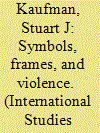

|
|
|
|
|
| Publication |
2011.
|
| Summary/Abstract |
This article examines the utility of opportunity theory, framing analysis, and symbolic politics theory in explaining the causes of ethnic war, focusing on the 1970s Mindanao case. Opportunity variables are present as expected, but process-tracing shows they do not operate according to the hypothesized mechanisms. The framing approach identifies several important dynamics. The resonance of frames was influenced by the salience of the issue highlighted, the narrative fidelity of the frame to preexisting cultural beliefs, the credibility of leaders proposing them, and processes of frame bridging. Symbolic politics theory offers the most complete explanation, embracing most of the alternative explanations' insights while filling in their logical gaps. The symbolist analysis begins with group myths justifying hostility on both sides, the result of past Christian-Muslim warfare. Combined with fears of group extinction, opportunity factors, and hostile popular attitudes, these myths enabled group elites to manipulate emotive symbols to justify mobilization against the other group, creating a security dilemma spiral that resulted in the outbreak of war.
|
|
|
|
|
|
|
|
|
|
|
|
|
|
|
|
| 6 |
ID:
175496
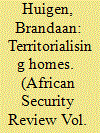

|
|
|
|
|
| Summary/Abstract |
This article draws on ethnographic data from South Africa to show that while burglaries may commonly be once-off incidents, many households are repeatedly victimised. In such situations, victims are retargeted and intimidated by the same burglars. Through two exemplary cases of middle- and lower-middle-income households, which are examples of ‘return’ and ‘prolonged’ burglaries, I illustrate that these burglaries are defined by four main characteristics: long duration, the targeted theft of possessions, remaining marks and the close proximity of burglars. I suggest that these burglaries are a way of laying claim to households through symbolic means, rather than physical confrontation. This has lasting social, emotional and financial repercussions for the victims. As relating to repeat-victimisation, burglaries deserve further attention from analysts.
|
|
|
|
|
|
|
|
|
|
|
|
|
|
|
|
|
|
|
|
|